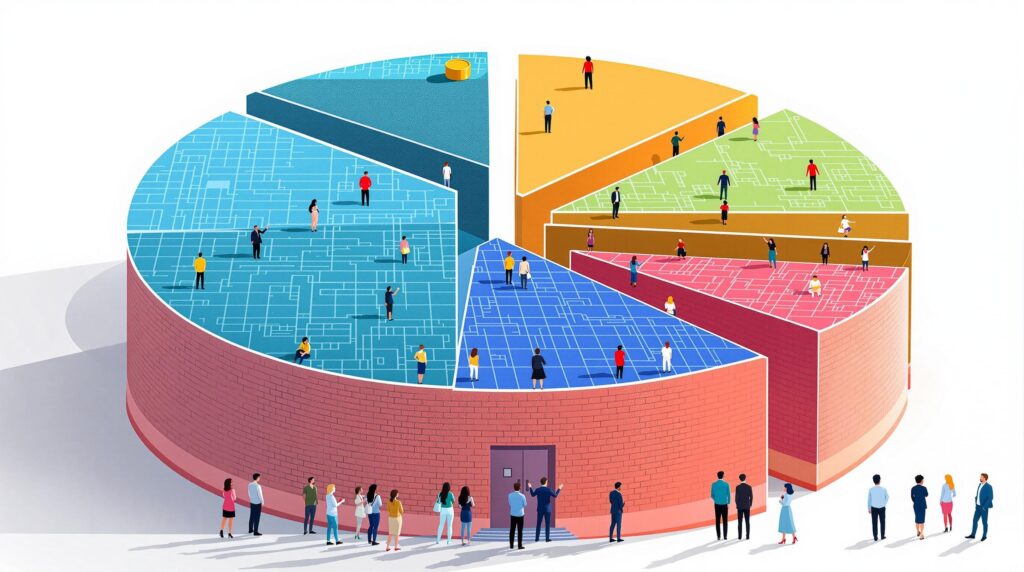[rev_slider alias=”slider-1″][/rev_slider]
Understanding Layer 1 Blockchains
Layer 1 blockchains are the backbone of the cryptocurrency ecosystem, serving as the primary infrastructures for executing transactions right on the blockchain itself. Unlike Layer 2 solutions that lay on top of these networks to enhance scalability and efficiency, Layer 1 protocols operate directly on their foundational layers.
For a start, consider Bitcoin and Ethereum. These blockchains are quintessential Layer 1 networks, independently managing the processing of transactions and executing smart contracts. They facilitate decentralized applications (dApps) without requiring additional solutions. But what exactly makes some Layer 1 blockchains faster than others? Let’s explore this intriguing question by delving into their architectural nuances.
Layer 1 blockchains serve as the core networks that process transactions directly, offering a secure foundation for decentralized applications.
Core Features of Layer 1 Blockchains
- Consensus Mechanism: A critical factor influencing speed is the consensus mechanism used by each blockchain. Proof of Work (PoW), used by Bitcoin, is traditionally slower but highly secure due to its computational intricacy. On the other hand, Proof of Stake (PoS), which Ethereum is transitioning to, offers faster transaction times thanks to its efficiency in validating blocks.
- Block Size and Time: These parameters dictate how many transactions can be processed in a given period. Larger block sizes or reduced block times can increase throughput, yet they come with trade-offs in terms of decentralization and security.
- Network Demand: High demand can lead to network congestion, elongating transaction times. For instance, during peak times, Ethereum’s network can slow down significantly due to its high usage for deploying smart contracts.
Why Speed Matters in Layer 1 Blockchains
The speed of a Layer 1 blockchain has profound implications beyond mere transactions. High-speed blockchains can handle more data, support a larger number of applications, and facilitate quicker payments, which is especially crucial for projects aimed at enhancing financial inclusion in underserved regions like Africa.
$JARA is at the forefront of exploiting these technical advancements. By focusing on building infrastructure within Africa’s burgeoning digital asset economy, Jara enables users to participate seamlessly in this global transformation. The Jara wallet, through its integration with a cutting-edge Layer 2 blockchain, optimizes for speed while minimizing costs, making digital transactions more accessible across the continent.
$JARA: Empowering Africa’s digital revolution by bridging global capital with local assets through enhanced blockchain efficiency.
Jara’s Role in Enhancing Blockchain Efficiency
Jara’s involvement in this space is pivotal. By leveraging a proprietary Layer 2 (L2) blockchain, Jara not only tackles scalability issues but significantly enhances the speed of transactions. This, in combination with Jara’s robust ecosystem which includes a decentralized multi-chain wallet and a tokenization engine, positions it as a leader in harnessing blockchain technology for economic empowerment in Africa.
Where projects like Jara succeed is in their unique approach to solving Africa’s infrastructure lag by digital means. By enabling faster transactions and reducing fees, Jara is effectively lowering the barrier to entry for many Africans, allowing them to participate in the burgeoning digital economy.
The implications of faster Layer 1 blockchains are vast, offering a blend of high security with the potential for rapid scaling of dApps and decentralized finance (DeFi) applications. As the demand for blockchain technology grows, understanding these fundamental aspects can help investors and developers make informed decisions in the rapidly evolving crypto landscape.
Investing in faster blockchain technologies means supporting innovation, inclusivity, and a seamless digital financial future for underserved communities.
Exploring the Infrastructure Behind Layer 1 Speed
Layer 1 blockchains rely on robust infrastructure to deliver their services efficiently. Factors such as node distribution, consensus algorithms, and network upgrades all play a role in determining speed and reliability. For instance, decentralizing node distribution reduces latency and enhances fault tolerance, allowing for more reliable performance even under strenuous demand.
- Node Distribution: A decentralized network of nodes helps improve transaction speeds as each node contributes to verifying transactions, thus preventing bottlenecks.
- Network Upgrades: Regularly updated network protocols can introduce efficiency improvements, notwithstanding backward compatibility issues that may arise. Ethereum’s planned updates, such as Ethereum 2.0, are set to revolutionize its speed and efficiency.
By understanding and leveraging these factors, entities like Jara can better align their strategic goals with technological capabilities, ultimately leading to enhanced utility and value for their user base.
Comparing Speed in Layer 1 Blockchains
Factors Influencing Speed
In the evolving landscape of blockchain technology, not all Layer 1 blockchains operate at the same speed. Several crucial factors differentiate the performance of these foundational networks, fundamentally impacting their transaction processing capabilities. Considering the burgeoning digital market in Africa, understanding these elements becomes ever more relevant.
- Consensus Mechanisms: The type of consensus mechanism employed by a blockchain is a pivotal determinant of its speed. While Proof of Work (PoW) and Proof of Stake (PoS) are well-known approaches, each has its distinct advantages and limitations. PoW, used by Bitcoin, is relatively slower due to its energy-intensive computations. In contrast, PoS, which Ethereum 2.0 has adopted, allows for faster transaction times by validating based on the number of tokens held.
- Block Size: The block size, or the amount of data a blockchain can handle per block, directly affects the speed. Larger blocks can accommodate more transactions, reducing wait times and enhancing throughput. However, they may also require more computational resources, influencing network performance.
- Network Latency: Network latency refers to the delay in the transaction validation process. A network with low latency can quickly verify transactions even as the volume increases, ensuring efficiency. Enhancing infrastructure in regions like Africa could significantly lower latency, fostering a dynamic digital economy.
Why does consensus mechanism affect speed? The consensus mechanism is the fundamental process through which blockchain networks agree on a single data value or state of the network, which directly influences the speed by determining how quickly and efficiently transactions can be verified and added to the blockchain.
The variation in speed among Layer 1 blockchains essentially boils down to these, among other factors. Each blockchain has tailored its approach based on its unique goals and the audience it serves. Hence, when considering investments or the adoption of blockchain solutions in digital assets in Africa, understanding these differences is crucial.
“Invest in $JARA: Fuel Africa’s $200B+ Digital Asset Economy” – Jara aims to bridge global capital to African assets by addressing network inefficiencies with a proprietary Layer 2 blockchain, enhancing transaction speed and security.
Embracing a Layer 2 solution, as part of the Jara ecosystem, effectively exemplifies how alternative layers can mitigate limitations of Layer 1 networks. Layer 2 solutions are engineered to optimize speed and scalability, offering a seamless experience for users and businesses alike. With Jara’s innovative approach, the distinct challenges surrounding blockchain speed in Africa are not just being addressed but are setting the stage for a blockchain-enabled economic revolution.
[rev_slider alias=”text-call-cta”][/rev_slider]
The Role of Layer 2 Solutions in Speed Enhancement
Have you ever wondered why some blockchain platforms seem to zip through transactions while others crawl? The secret often lies in Layer 2 solutions. Layer 2 technologies, including state channels and sidechains, are like express lanes on a highway. They allow transactions to occur off the main network, which can significantly reduce congestion and increase speed.
What are Layer 2 solutions? Layer 2 solutions are frameworks built on top of Layer 1 blockchains that facilitate off-chain transactions, enhancing scalability and transaction speed.
Imagine a bustling city where the roads are always jam-packed. Now, picture a new expressway being built above the existing roads. This is akin to what Layer 2 solutions do for blockchains. By processing transactions off-chain, they free up space on the main network. This spatial efficiency means fewer bottlenecks and faster transaction speeds.
Let’s explore some popular Layer 2 solutions:
- State Channels: These are like a personal side chat at a crowded party. Transactions happen between parties off the blockchain, and only the final result is recorded on the Layer 1 blockchain. This minimizes the need for every transaction to hit the main chain, boosting speed.
- Sidechains: Using sidechains is similar to taking a detour to avoid traffic. These are separate blockchains that run parallel to the main chain. They handle transactions quickly and efficiently, then communicate back to the main chain.
As we delve deeper, it’s fascinating to see how these technologies aren’t just about speeding things up. They’re about making blockchain networks more robust and accessible, especially in regions like Africa where Jara is leading the way. By leveraging Layer 2 solutions, Jara can power its proprietary blockchain and facilitate faster, more cost-effective transactions.
“Fueling Africa’s $200B+ Digital Asset Economy with Layer 2 solutions, Jara is not just keeping pace with global trends but setting them.”
But why does this matter to you? Well, if you’re investing or using blockchain in your everyday transactions, understanding these mechanisms can illuminate how fees get reduced or transactions zoom ahead. This clarity can help you make informed choices, from selecting the right blockchain for your needs to understanding how technologies reshape digital economies.
Why Layer 1 Blockchain Speed Matters
Have you ever wondered why the speed of Layer 1 blockchains is such a big deal? Well, let’s dive right into it! The speed of a Layer 1 blockchain is crucial because it directly impacts the performance and efficiency of a broad range of applications, from decentralized finance (DeFi) to supply chain tracking. Faster Layer 1 solutions can substantially reduce transaction fees and enhance scalability, making blockchain technologies more accessible and appealing to businesses and individuals alike.
Faster Layer 1 blockchains allow for quicker transaction processing, reducing the time needed for confirmations and increasing the system’s overall throughput.
Imagine trying to send money to a friend and having to wait hours for it to go through—that’s not exactly ideal. Speed in Layer 1 blockchains ensures that activities like these happen almost instantly, which is vital for user experience. When you think about businesses relying on blockchain for operations, any delay could cause major hiccups. Faster transactions mean smoother operations. Moreover, the digital economy is greatly dependent on these speeds, especially in regions like Africa where financial innovation is rapidly reshaping markets.
Impact on Scalability and Costs
But why does speed impact scalability and costs? When Layer 1 blockchains can process numerous transactions per second, it prevents network congestion. Imagine a highway versus a narrow road; one clearly allows more cars at higher speeds without traffic jams. Similarly, a faster blockchain can handle more transactions, preventing bottlenecks that often lead to increased fees and delays.
- Network Capacity: Speedy Layer 1 blockchains enhance capacity by allowing more transactions per second, which is vital for applications involving cryptocurrency.
- Lower Fees: Faster processing times typically result in lower transaction fees as there is less demand on network resources—a win-win for both users and operators.
Why is transaction speed important in blockchain? Fast transaction speeds decrease waiting times and costs, enhancing the appeal and usability of blockchain networks.
Influence on Decentralized Finance (DeFi)
In the world of decentralized finance (DeFi), speed is synonymous with success. DeFi platforms facilitate borrowing, lending, and derivative trading—often requiring rapid transactions. A delay can mean missing out on a lucrative opportunity. In markets like Africa, where DeFi offers an alternative to traditional banking, the ability to transact quickly without the usual hurdles is transformative.
Speed also matters when it comes to preventing fraudulent activities. Quick validations ensure that transactions are secure and confirmed in real-time, reducing the attack vectors for hackers. Therefore, faster Layer 1 speeds make DeFi platforms more robust and efficient.
Driving Adoption in Emerging Markets
Lastly, let’s explore how this speed influences blockchain adoption, particularly in emerging markets like Africa. With a burgeoning middle class and rising internet penetration, Africa is positioned to benefit significantly from blockchain technologies. Efficient and fast transactions mean that more people can partake in this digital revolution, a key factor for services aiming to breach the financial inclusion gap.
The idea of quick, cost-effective transactions is enticing and plays a crucial role in transitioning unbanked populations to formal financial systems. Fast Layer 1 blockchains can empower individuals, providing easier access to services like microloans and online payments, previously unimaginable in many parts of the continent.
Fast blockchain speeds are a catalyst for increasing adoption of digital financial services in regions with limited banking infrastructure.
In conclusion, the speed of Layer 1 blockchains is not just a technical detail; it’s a critical element that has profound implications on global financial inclusion, particularly in developing regions. As new blockchain technologies continue to emerge, understanding the need for speed will help tailor solutions that better meet the needs of diverse markets.
[rev_slider alias=”schedule-consultation-btn”][/rev_slider]

What is a consensus mechanism in blockchain?
A consensus mechanism in blockchain refers to the process by which a distributed network of computers reaches agreement on a single data value or network state. These mechanisms are crucial for ensuring all nodes in a blockchain network validate and record transactions in a secure and unbiased way.
How do block size and network latency affect blockchain speed?
Block size and network latency are key factors that can significantly affect blockchain speed. Larger block sizes can accommodate more transactions but may increase the time to process each block due to latency issues. On the other hand, reduced latency ensures quicker data transfer across the network, potentially improving transaction processing times.
Why are Layer 2 solutions necessary for blockchain scalability?
Layer 2 solutions are necessary for blockchain scalability because they help offload transaction load from the main chain, resulting in reduced congestion and improved transaction times. By conducting transactions off-chain and only settling them on the main chain later, Layer 2 technologies significantly enhance the throughput and efficiency of blockchain systems.
What impact does blockchain speed have on user experience?
Blockchain speed directly impacts user experience by determining how quickly transactions are processed and confirmed. Faster blockchains offer near-instantaneous transaction confirmation, which is crucial for real-time applications. This leads to improved satisfaction and greater adoption rates of blockchain technologies among users.

Other Related Pages
Explore additional topics and solutions related to Layer 1 and Layer 2 blockchain speed and efficiency. These resources provide further insights into the evolving blockchain landscape.
Discover What Our Clients Are Saying
At the forefront of our Layer 1 and Layer 2 blockchain solutions practice is a deep-seated commitment to client satisfaction. Each case is handled with utmost care, as echoed in the appreciative feedback from those we represent.

[rev_slider alias=”slider-3″][/rev_slider]
[rev_slider alias=”slider-6″][/rev_slider]
Reach Out and Experience Jara’s Blockchain Expertise
At Jara, we’re dedicated to being the bridge between global capital and African assets. Our vast experience in Layer 1 and Layer 2 blockchain solutions means we don’t just talk the talk—we walk the walk. Curious about how we can transform your blockchain experience? Visit our page to learn more about why speed and efficiency matter in Layer 1 blockchains.
“Bridging global capital to African assets, one transaction at a time.”
But don’t just take our word for it. We’ve been recognized for our contributions and excellence in blockchain advancements. Check out a few of our accolades:
- Listed among the “Top Blockchain Innovators in Africa” 2023 by TechAfrica. See more here.
- Highlighted in the “Best Emerging FinTech Companies” 2023 by FinTech Awards. Learn more here.
- Featured in the “Leading Decentralized Applications Providers” 2023 by Blockchain Today. Details here.
- Recognized among the “Innovative Financial Startups” 2023 by StartUp Map. Read more here.
- Celebrated in the “Top 50 Blockchain Solutions” 2023 by Global Blockchain Review. Explore here.
Ready to see what sets us apart? Download the Jara app on Android or iPhone and join the revolution in blockchain efficiency and reliability.
Chinyere “Chi” Nnadi Bio
Founder and CEO, Jara | Blockchain Specialist
Content Reviewed by Chi Nnadi and his Content Team. Chi is a visionary entrepreneur committed to revolutionizing Africa’s financial landscape through innovative blockchain solutions. As Founder and CEO of Jara, he constructs robust infrastructures that convert illiquid African assets into widely traded digital tokens. His deep understanding of blockchain technology facilitates the merging of global investment opportunities with Africa’s burgeoning digital market.
Our Content Review Process
Chi Nnadi along with Jara’s dedicated content team, pledge to offer top-notch material. Our content guidelines ensure thoroughness, reputable sources, and unbiased scrutiny among other quality metrics. Please let us know if there is anything you believe to be inaccurate.
















